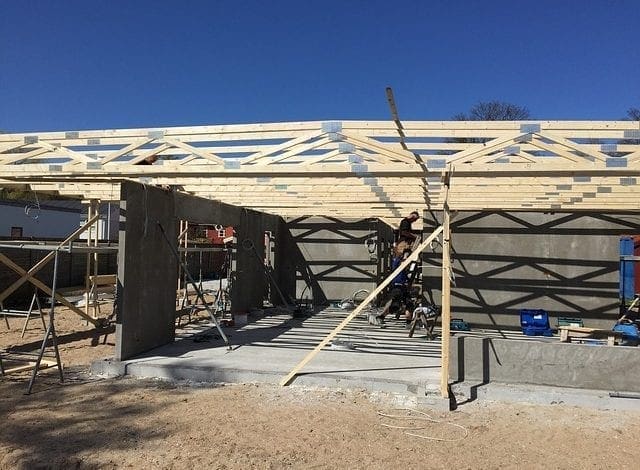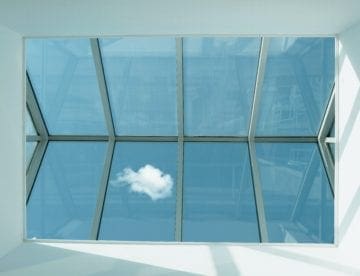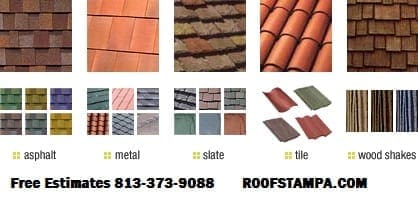Buying a new roof for your house or commercial property isn’t like choosing which type of socks to wear in the morning. Choosing a new roof is a major decision and something that’s not made lightly. If your building has flat roof construction, the materials you can buy for this type of roof are vastly different than for pitched roofs. Why? Because your run-of-the-mill pitched roof materials will leak if applied to a flat surface. Here’s what you need to know about the different materials used in flat roofs construction.
Why You Can’t Put Traditional Roofing Materials on a Flat Roof
Technically, you can put any roofing material on a flat roof. But that doesn’t mean it’s a good idea. The reason why traditional roofing materials like shingles and tiles don’t work for a flat roof is because these materials overlap. Overlapping materials are ideal for molding to the angles of a pitched roof so rain, snow, and debris don’t accumulate on the roof’s surface. A flat roof with no angles or pitch means water is likely to pool on the roof and make its way under the overlaps and seams. As a result, substrates will rot, and leaks will find their way into the building.
Rule of thumb? For flat roofs, construction must be free of seams to prevent water ingress.
Any openings in a flat roof are a disaster waiting to happen. The goal with flat roofs construction is to create a water-proof membrane or barrier so leaks don’t occur and cause damage to the building’s interior. For a flat roof, covering the surface with a tarp-like material or coating it with water-proof substances protects the building from water damage. Mostly, PVC membranes, tar coatings, and silicon are used in flat roofs construction.
What are the different flat roofs materials?
Materials used in flat roofs construction are vastly different than those used for angled or pitched roofs. The most common types of roofing materials installed on flat roofs are:
- PVC
- TPO
- Bitumen
- Built-up Roof
- EPDM
- Spray-on Silicon
On average, each of these materials will last between ten to 20 years. TPO is the least durable and may only last for seven years, depending on the climate and building’s maintenance levels. With adequate care, a PVC flat roof can last for up to 30 years. Proper installation from an experienced roofing contractor in Tampa will ensure a long lifespan for the roof no matter which materials you use.
How much does a flat roof cost on average?
Understandably, you might assume that installing a flat roof would cost less than installing a pitched roof. After all, contractors won’t have to wear harnesses and the risk of falls and injuries may be lessened. But counterintuitively, flat roofs can sometimes cost about the same or more than a similarly-sized pitched roof.
Working on a flat roof can be hard on the back and painful. Flat roof materials often require several steps to complete the construction. Sealant and adhesives must be applied, and in the case of modified bitumen, a torch must be used to heat the sealant and create a water-proof barrier. All of these things will add to the overall cost of a flat roof installation. Keep in mind, labor prices vary depending on location. But in general, you can expect to pay the same for a flat roof as you would for a pitched roof at 10/12 pitch.
Why would someone construct a flat roof anyway?
Installing a flat roof on a building can seem pretty risky. Flat surfaces mean water can pool and sit on top of the building. Debris can also accumulate far more easily on a flat roof than a roof with sizable angles. Flat roofs aren’t much cheaper to install than a pitched roof, either. In addition, flat roofing materials don’t last as long as many traditional roofing materials, like tile or metal.
So why would someone court a potential disaster in the first place by installing a flat roof? Well, because flat roof construction is convenient when installing a new addition to a building. Also, some people may prefer the look of a flat roof.
Flat Roofs: Aesthetics and Convenience
When someone puts an addition onto their house or commercial property, flat roofs will blend in more easily. An unblended pitched roof on an addition can make the building look busy and awkward. When thinking about the resale value and how long a house will sit on the market, ensuring the building has good curb appeal is critical. Many architectural styles call for clean, simple lines that flat roofs are suited for. For commercial buildings especially, flat roofs give you a convenient place to install things like the HVAC system.
True, a flat roof makes it easier for water and debris to accumulate. But despite the name, a flat roof isn’t 100% flat. Flat roofs are constructed in a similar fashion to a gutter system. There’s a very slight angle to the roof so any water on the surface is encouraged to drain into a downspout. Regardless, flat roofing materials have to be strong enough to withstand high winds, water, and debris accumulation.
Flat Roof Construction: A Takeaway Message
Aesthetics and cost aren’t always the most important factor when considering the type of material to install on a roof. The way your roof is constructed, the angles and pitch, will also play a role in determining which materials you ultimately have installed on the roof. In the Tampa Bay area, we see a lot of rain, storms, and debris. Choosing the best material for your flat roof is critical to ensuring the system’s lifespan and making sure you get the most value for your money.
In the next article, we’ll explore in more detail the different materials for flat roof construction. We’ll cover the pros and cons, and when you might want to pick one type of material over the other for your specific building. If your roof is nearing the ned of its lifespan, give us a call today at Code Engineered Systems at 813.373.9088 for a free, no-obligation quote.




